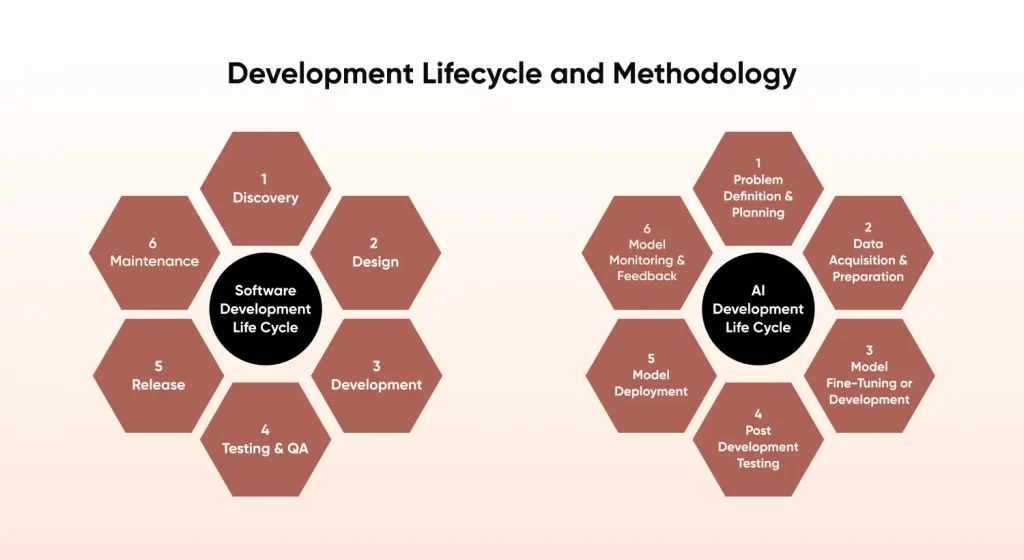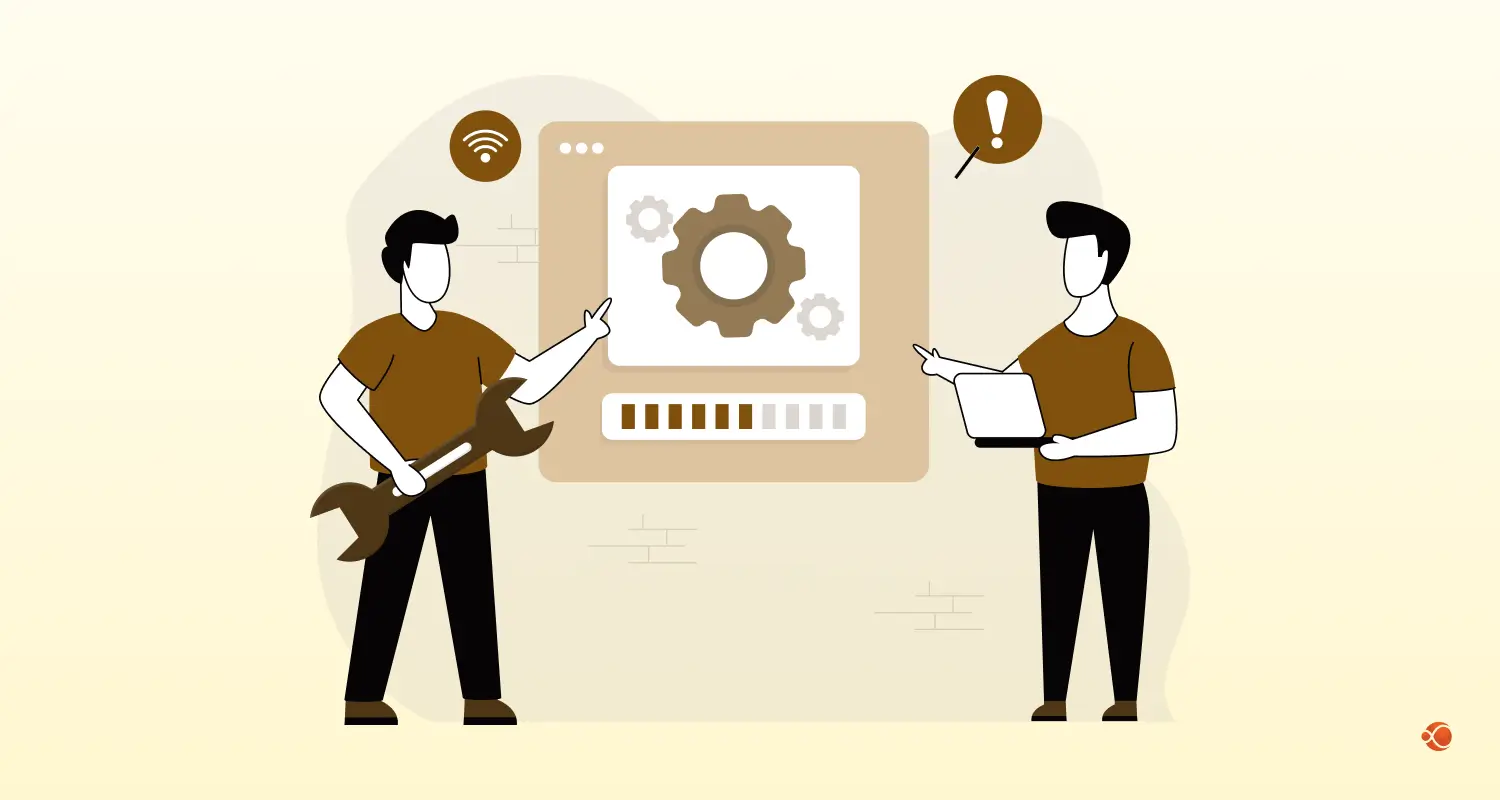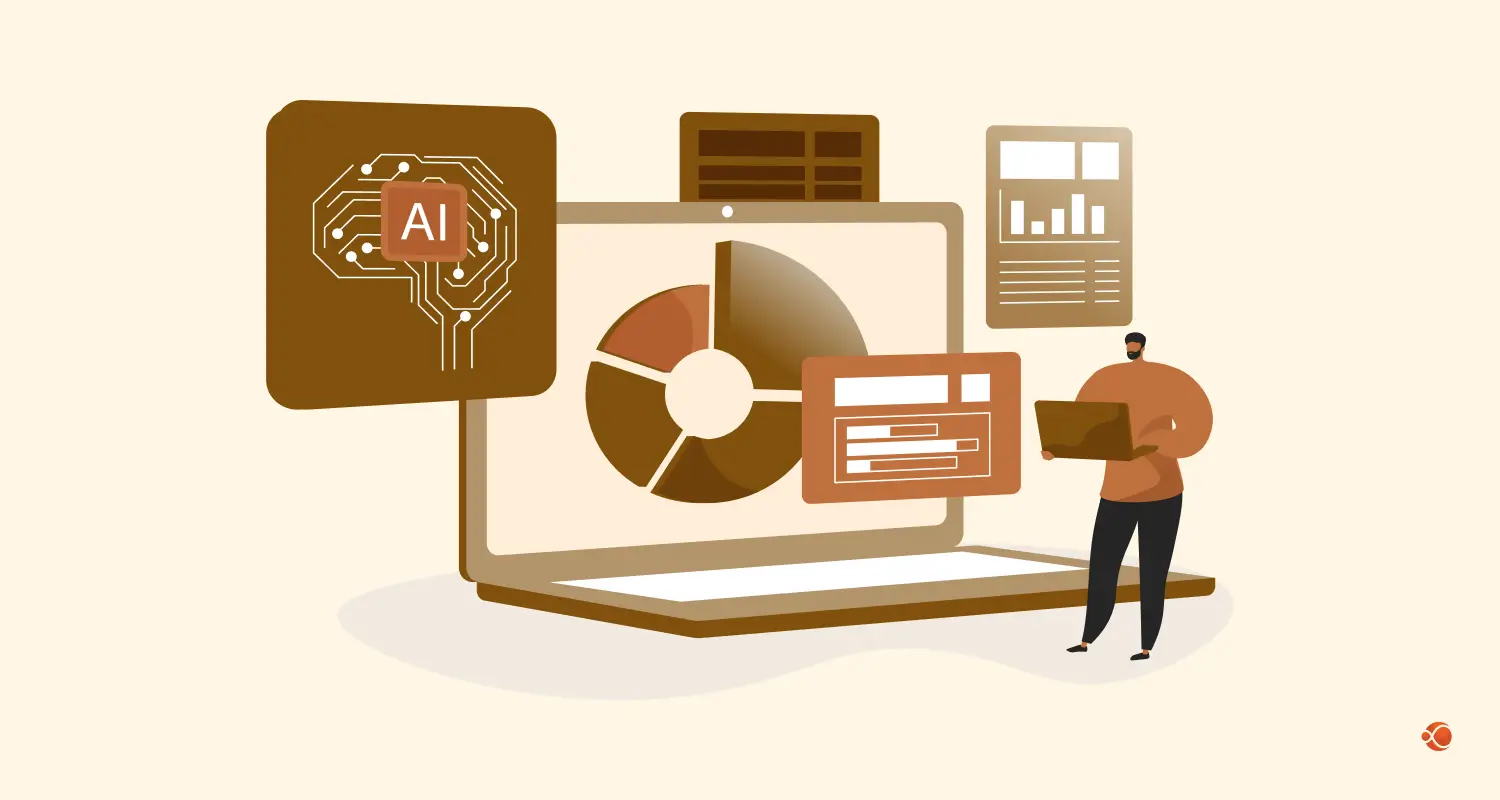Quick Summary: Deciding between AI vs traditional software isn’t easy. Businesses struggle to decide between reliability and innovation. Do you stick with proven, rule-based systems or invest in adaptive, data-driven AI? This blog breaks down the differences, advantages, and use cases so you can make the right choice for your business.
Imagine you are faced with a decision that could change the way you work forever. You can either stick to what you know, something that is trusted, familiar, and gets the work done, or you can take a leap into the future with AI, a technology that is capable of learning, adapting, and evolving with changing times. Which path will you choose?
Answering this question is not as straightforward. The choice between AI vs traditional software is not limited to a technical dimension; it affects the planning and strategy for your business moving forward. Whether you are a small business owner, a developer, or someone looking to enhance productivity, the right technology can boost or limit your success.
But with so many options available, how do you decide what’s best for your unique needs? 95% of senior leaders are already investing in AI. Most of them also report gains in productivity, efficiency, and customer satisfaction.
Today, we’ll explore the key differences between AI and traditional software. This enables users to make an educated decision. AI represents the future, driving innovation and adaptability, while traditional software offers proven reliability and stability. Let’s dig into the debate and see which approach works best for your business.
Traditional Software: The Backbone of Business
Traditional software is not obsolete; it remains the essential foundation for various businesses across different industries. Its value is mainly based on reliability and predictability.
What is Traditional Software?
Traditional software development refers to any software that is built on a rigid, step-by-step logic, where the developer has complete control. They write the code that follows a specific set of instructions or commands. This software is designed and built to solve a predefined list of problems with a specific approach.
What Are The Traditional Software Advantages?
- Precision and Reliability: It is ideal for single tasks that require accurate answers, such as financial calculations or order processing.
- Predictable Development: Traditional software projects often have clearly defined timelines and costs, enabling teams to stay on track and remain aware of the overall effort required for the project.
- Security and Audibility: Since the entire application is based on clear logic, it makes it easier for teams to audit the platform for security and compliance issues.
What Are The Limitations Of Traditional Software Development?
- Lack of Adaptability: Traditional software cannot handle new data or unforeseen circumstances without requiring manual updates to the code and logic of the application.
- Limited Scope: They excel in tasks for which they are assigned, but struggle with unstructured tasks such as NLP or image analysis.
AI-Driven Software Development: The Engine of Innovation
AI software development services function on the basis of adaptability. AI is the engine that drives modern personalization and automation requirements.
What is AI-Powered Software Development?
Instead of being programmed by rules, AI models are trained on data. This training allows the models to learn how to identify patterns and make inferences. The more data it consumes, the smarter it gets.
What Are The Benefits of AI Software?
- Learning and Adaptability: It evolves and improves over time, utilizing data as an asset that enhances understanding.
- Automation of Complex Tasks: It is capable of automating tasks that even scraping techniques cannot complete. You can now easily summarize long paragraphs, identify objects in a video feed, and use cases.
- Enhanced User Experience: AI offers personalized features, including intelligent recommendation engines and AI-powered chatbots.
What Are The Limitations of AI-Driven Software?
- High Upfront Costs: AI development costs can escalate without you realizing it. Collecting data, cleaning it, and training models can all require serious investment. For startups, this wall can feel a little too high to climb. However, with the help of AI consulting services, you can reduce both time and cost by guiding the implementation process.
- The Black Box Problem: AI doesn’t provide transparency into how it reached a conclusion or answer, which can cause problems with compliance and regulations for certain sensitive industries or use cases.
- Continuous Maintenance: AI isn’t a one-and-done project. Models require regular monitoring, retraining, and fine-tuning to maintain accurate performance. Without this upkeep, performance can drop off quickly.

Key Criteria Comparing AI vs Traditional Software: 9 Core Differences
| Criteria | Traditional Software | AI Software |
| Fundamental Principle | Built on predefined rules and deterministic logic (if-then statements). | Built on data, learning from large datasets using algorithms. |
| Development Lifecycle & Methodology | Linear and structured (Waterfall or Agile), with explicit code. | Iterative and experimental, focused on data collection, cleaning, and training models. |
| Dependency on Expertise | Requires skilled software engineers and product managers. | Requires collaboration with AI developers and domain SMEs for effective solution-building. |
| Evaluation & Testing | Testing focuses on functionality, logic, and predictable outputs. | Testing involves continuous evaluation, including identifying failure points and assessing model performance. |
| Post-Deployment Monitoring | Generally stable post-deployment with minimal monitoring. | Requires ongoing monitoring for model drift and performance degradation. |
| Development Cost & ROI | Easier to estimate with fixed scope and predictable timelines. | High upfront costs due to data preparation, but long-term ROI can be promising. |
| Decision-Making | Based on deterministic logic for structured and repetitive tasks. | Makes probabilistic decisions by recognizing patterns in data, enabling automation of complex tasks. |
| Task Handling | Designed to complete specific, well-defined tasks with clear start, middle, and end. | Designed for open-ended, complex tasks requiring learning, reasoning, and judgment. |
| Data Handling | Works well with structured data (e.g., relational databases). | Processes vast amounts of unstructured data (e.g., text, images, audio) and extracts insights. |
Fundamental Principle: Rules vs. Data
Traditional software typically operates according to predefined rules. It is built with explicit, deterministic logic. It works on if-then statements and logic. For instance, a traditional payroll system will have a clear set of rules for calculating salaries and deductions. You input the data, and it returns a predictable, fixed output every time.
AI software, in contrast, works on data. It utilizes algorithms and models to learn from large datasets. Instead of being explicitly programmed for each condition, it self-learns and understands patterns for making decisions. You must have seen this in action from any streaming service’s recommendation engine. It learns from the user’s viewing habits and suggests content accordingly.
This process operates on a probabilistic value, and not a deterministic one. Such data isn’t guaranteed to be 100% accurate. The accuracy of such models is based on the quality of the information. That’s why AI results can improve and evolve over time as they take in more information and learn from feedback.
Development Lifecycle and Methodology

Conventional software development is a straightforward, step-by-step process. It typically uses management practices such as the Waterfall or Agile approaches. It follows properly defined procedures like requirements gathering, system design, code writing, testing, and deployment. Developers write rules that the system obeys, yielding repeatable and correct results. This serves projects with clearly defined objectives and invariant requirements best.
AI-driven software development is an iterative and experimental cycle that focuses less on writing explicit code and more on data. This process involves collecting, cleaning, and preparing data. You will need to hire dedicated AI developers to train the model, evaluate its performance, deploy it, and monitor its operation. This is not a point A to point B process; it is a continuous loop. The model performance improves as it gets more data.
Dependency on Expertise
Another important factor affecting AI vs traditional software comparison is the type of expertise needed. Traditional software development requires the knowledge of skilled software engineers and product managers. AI systems will need the knowledge of Subject Matter Experts (SMEs). These experts have critical domain knowledge that guides everything from data selection to result interpretation. This is a key reason why companies hire AI developers who can collaborate with SMEs to build effective solutions.
Evaluation and Testing
Testing for traditional software is focused on functionality and logic. A test suite helps verify the application’s intended functioning and whether the outputs are predictable. AI vs traditional software examples highlight such differences. For a traditional payroll system, testing checks if the numbers are correct. But for AI systems, testing also involves playing “mind games” to find their failure points and assess their quality.
Post-Deployment Monitoring
Once a traditional software system has been tested and deployed, it is generally stable and requires minimal continuous monitoring. Continuous monitoring of AI systems opens the door to innovative AI business ideas, such as predictive maintenance services or automated customer support solutions. However, AI software solutions need continuous and active monitoring. Their performance can degrade over time because of model drift, where real-world data changes from what the model was trained on. Hence, you need to assign a dedicated team to check this regularly and retrain the system to ensure system reliability and accuracy.
Cost of AI vs Traditional Development
The cost of AI vs traditional software is also an important factor in the AI vs traditional software development debate. Traditional software projects have a fixed scope and agenda; hence, the costing for such projects is generally easier to determine. Development timelines and expenses can be estimated with a higher level of certainty, which makes it easier to budget for a custom software development service with a clear return on investment.
At first glance, AI costs appear to be very high. They require undergoing time-consuming and expensive processes. This includes data collection, cleaning, and preparation, among others. Hiring AI developers and data scientists also adds to the initial investment budget. However, while the upfront cost is often greater, if it is perfectly aligned with the business goals, the long-term ROI can be just as promising.
Decision-Making
Traditional software makes its decisions based on deterministic, predefined logic, whereas AI-driven software makes decisions after recognizing patterns in the data, enabling automation and completing complex tasks more efficiently. In traditional software development, software always produces the same output for a specific input.
AI doesn’t work with a pre-defined set of rules and regulations. Instead, it learns from large amounts of data and can handle complex tasks with ease. Businesses often collaborate with an AI agent development company to efficiently implement these intelligent systems. For example, a fraud detection system can analyze patterns of past transactions and identify unusual activity, even identifying new types of fraud.
Task Handling
AI systems aren’t built on a predefined, strict set of rules. Instead, they learn from large amounts of data and can take on tasks that would be too complex to code by hand. For example, a fraud detection tool can study patterns across thousands of past transactions and flag unusual activity. This even allows it to spot entirely new types of fraud that haven’t been seen before.
Data Handling
The difference between AI vs traditional software when it comes to data handling is also important to note. Traditional programs work well with properly structured and well-defined data. AI software development typically involves adapting to process large amounts of unstructured data. For a traditional program, you can imagine data presented in proper rows and columns of a relational database, like customer records, financial transactions, and sales figures. The rigid schema of the database ensures data integrity, making it easy to query and report on.
What Is Better: AI or Traditional Software Development For Your Business
Now that you understand the differences between AI vs traditional software, the next question is, how to make an informed choice between Artificial Intelligence and software development? The right solutions will always be customized to your unique needs, whether you are building a custom software development service from scratch or upgrading existing systems to be smarter, faster, and more adaptive. The key is matching the technology to your goals, budget, and long-term vision.
When Traditional Software is the Right Choice:
- Rule-Based Task: It is well-suited for tasks that have been well-defined, with unchanging rules and logical, step-by-step processes.
- Predictability and Reliability: Traditional software operates on deterministic logic, enabling you to consistently predict outcomes. This makes it highly reliable and suitable for regulated industries, where every decision must be traceable.
- Cost and Timeline: Traditional development projects have a more predictable scope and cost.
When to Choose AI Software:
- Handling messy data: AI shines when there’s a mountain of information like text, images, and videos that traditional systems find difficult to process.
- Tackling tough decisions: AI can step in for complex tasks that need proper learning, reasoning, and judgment, such as detecting fraud, predicting equipment failures, or optimizing supply chains.
- Personalizing experiences: By understanding how users behave, AI can offer recommendations and services that feel tailored just for them.
Combining AI and Traditional Software Across Industries
In most cases, you will not be completely on one side of the AI versus traditional software debate; the most effective solutions often blend the reliability of traditional software with the innovation of AI. Here is how this will look for core industries:
Banking and Finance
Traditional Core: Banks typically rely on traditional software for their foundational and security-critical functions, such as managing customer accounts, processing transactions, and handling regulatory compliance.
AI integration in BFSI: AI can then be layered on top of these systems to improve functionality. For instance, an AI-powered fraud detection system will be able to analyze billions of transactions in real-time that traditional human teams cannot keep up with. Similarly, AI chatbots can provide 24/7 customer support, and machine learning models can offer smart solutions for wealth management and assess credit scores.
Retail
Traditional Core: The backbone of all retail businesses lies in their traditional software for inventory management, point-of-sale systems, and supply chain logistics. These systems ensure products are available where they need to be and transactions happen smoothly.
AI Integration in Retail: AI in the retail industry is providing valuable and personalized shopping experiences. Recommendation systems can provide accurate product suggestions by analyzing customers’ purchase histories and browsing behavior. AI is also helpful for demand and sales forecasting, as well as managing stock levels.
Healthcare
Traditional Core: Hospitals and clinics utilize traditional electronic health record (EHR) systems to securely store patient data, manage billing, and schedule appointments. It is important for these systems to be secure to protect patients and maintain their privacy.
AI integration in healthcare: AI is used to automate clinical and administrative workflows. AI-powered diagnostic tools enable radiologists to analyze medical images like X-rays and CT scans, with greater speed and accuracy, identifying anomalies more effectively. Predictive maintenance can be used to identify patients at risk of hospital readmission.
Education
Traditional Core: Educational institutes rely on Learning Management Systems for course management, grading systems, and record-keeping. Such traditional platforms have always provided the structure and framework for both students and teachers.
AI Integration for Education: AI is utilized to personalize the learning process through intelligent tutoring systems. It can analyze a student’s performance, adapt the curriculum to their individual learning pace and style. Dedicated AI-powered tools can also be automated for the grading of multiple-choice and short-answer questions.
Final Words
There is no clear answer to what is better: AI software solutions vs traditional software. Traditional systems provide a base foundation for any business, whereas AI software solutions serve as the engine of modern-day innovation and personalization. Combining the power of both can help you build resilient, scalable, and highly performative applications that better comply with complicated regulations.
Understanding the difference between AI vs traditional software is only the first step. The next step is to apply this knowledge to your business. For this, you can start with an AI MVP development agency to test out your product idea, and then commit to a full-scale project once you feel confident.
FAQs on AI vs Traditional Programming
What Are the Main Differences Between AI and Traditional Software?
Traditional software follows a predefined set of rules and logic paths. They execute specific commands exactly as mentioned in the business logic and codebase. AI software learns from data patterns and can make decisions or predictions without explicit programming for every scenario. While traditional software provides predictable and consistent outputs, AI systems adapt and upgrade their performance over time through the use of ML algorithms.
What Are the Cost Implications of Choosing AI Over Traditional Software?
AI development has a high barrier to entry in terms of cost. If you are new to using such models, you will need to invest significantly in data collection, model training, and possibly acquiring data engineers from a reliable source. Traditional software development can get expensive depending on the type of project you are working on, but it has a lower entry barrier. The ideal choice is to partner with an AI software development company that knows how to integrate AI into traditional software architecture, thereby reducing operational costs, automating complex decision-making tasks, and freeing human resources for higher-level tasks.
How Do Maintenance and Updates Differ Between AI and Traditional Software?
Traditional software maintenance involves pushing code changes to fix bugs, add new features, and apply security patches. AI software maintenance is based on endless data monitoring, model retraining, and performance evaluation to prevent degradation in accuracy over time. While traditional software updates are predictable and scheduled, AI maintenance is ongoing and requires continuous monitoring for data drift and changes in model performance.
Can I Combine AI and Traditional Software in One Solution?
You can combine AI and traditional software to get the best of both worlds. Traditional software can be used for structuring important processes, setting up the fundamentals of the user interface, and setting rules for data management. AI components can then focus on adding more usability and efficiency for pattern recognition, making predictions, and automating decision-making. This combination leverages the reliability of traditional software with the adaptive capabilities of AI systems.
What Skills or Expertise Are Required for AI Software vs Traditional Software Development?
Traditional software development is based on knowledge of programming languages like Python, Ruby on Rails, .NET, JavaScript, React, Angular, and many more. However, to have skills in AI software development, you need a solid understanding of arithmetics, logical reasoning, data science, and AI programming languages like Python, TensorFlow, or PyTorch.







